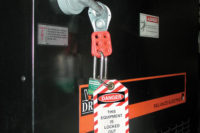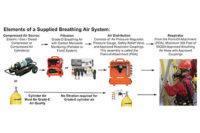The OSHA Respiratory Standard 29 CFR 1910.134 covers both air purifying and airline respirators. Determining the type of respirator to use is dependent upon a workplace assessment. Once the assessment is completed and engineering controls have been ruled out, the appropriate airline respirator can be selected.
Airline systems deliver air to a variety of face pieces; the type of face piece to be used depends on the situation and the best fit for the job at hand. There are tight fitting full-face and half-mask respirators, loose fitting hoods, helmets, and self-contained breathing apparatus (SCBA). Supplied air respirators operate in one of two modes: continuous flow (CF) or pressure demand (PD). Continuous flow gives the user a steady flow of air, while pressure demand releases air to the user only when the pressure differential is created as he or she breathes in.
| To read more about Air Purification Respirators, CLICK HERE |
Types of SAR respirators
1. Tight Fitting Full-face and Half-mask Respirators – These respirators are used in IDLH situations and when gases and vapors are present that APR’s cannot protect against. Fit testing is required when using a negative or positive pressure tight fitting mask.
2. Loose Fitting Hoods – Hoods can be either disposable or reusable, and are typically made of Tyvek®, coated Tyvek QC®, polyethylene or polypropylene. They are typically used in areas containing cleaning chemicals where there is a chance of splash or contamination, or in situations when a cartridge type respirator would have ineffective sorbents for the chemicals being used. Many industries use these types of systems, including healthcare, pharmaceutical, food and beverage and manufacturing. Loose fitting hoods do not require fit testing.
3. Air Supplied Helmets – These are typically used in grinding, sanding, painting and sometimes blasting applications. Helmets provide top impact and penetration protection and also protect the wearer from abrasive rebound and airborne contaminants. These are considered loose fitting and fit testing is not required.
4. Self-Contained Breathing Apparatus (SCBA) – SCBA’s are primarily used in IDLH situations or when the concentrations of chemicals or substances are unknown. Firefighters and those responding to hazardous material situations are probably the most recognized users of SCBA’s. The main advantage of using a SCBA is maintaining full mobility because the user is not attached to an airline.
Air supply
According to OSHA, compressed air must meet the requirements of the Compressed Gas Association (CGA) specifications of Grade D breathing air. Grade D breathing air can come from an ambient air pump, an air compressor or plant air, which can be filtered and regulated. The CGA requirements specify oxygen content and contaminant limits.
Airline respirators are available as high pressure or low pressure systems. A high pressure airline respirator is the best option when a long airline is required (up to 300 feet), or if the air supplying the mask needs to be heated or cooled. The air source for a high pressure airline respirator often requires an air filtration system to provide Grade D air, and it is important to monitor the user’s carbon monoxide level. Air cylinders, or bottled air, are another source of high pressure breathing air. Air cylinders are used in confined spaces or areas where portable air is needed. A low pressure airline respirator uses a portable ambient air pump which delivers filtered, low pressure air. Air pumps transfer air from a clean source or compressor that provides Grade D air. The airline length of a low pressure airline respirator with an ambient air pump is generally limited to 100 to 150 feet (depending on the ambient air pump manufacturer recommendations) and supports only a few workers. There are also fewer options to heat and cool the air supplying the mask with a low pressure airline respirator.
Quick connect couplers
The brand of quick connect couplers, also referred to as fittings, used on airlines can vary by manufacturer. Different brands of respirators use different fittings for their hoses and connection points. Some of the more common fittings used are: OBAC, Hansen, Schrader and Industrial Interchange and come in different sizes such as 3/8", ¼" and ½". Fittings must be the same brand and size to connect together and work properly.
Exposure limits
Several agencies are responsible for researching and establishing contaminant exposure limit levels for hazardous substances. The American Conference of Governmental Industrial Hygienists (ACGIH) is a voluntary organization of safety professionals that develops and reviews exposure limit values. ACGIH results are based on animal, human and industrial studies. The National Institute for Occupational Safety and Health (NIOSH) is a federal agency that conducts research on safety and health concerns. NIOSH is responsible for developing and revising recommended exposure limits for hazardous substances. Their recommendations are then conveyed to OSHA.
Sources
29 CFR 1910.134 Respirator Protection Standard
Grainger Quick Tip #275
Allegro Industries
Bullard
3M



